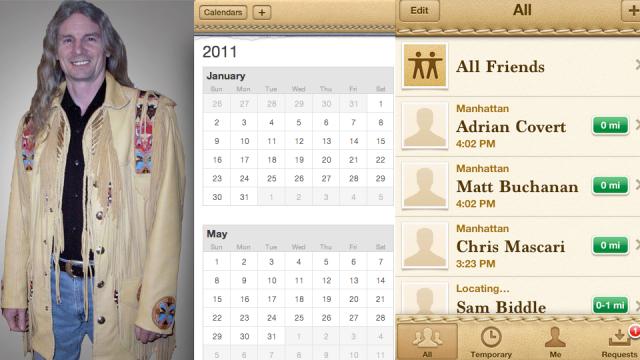Apple’s UI design has, for a long time, subtly mimicked reality — the brushed metal of iTunes riffing off a jukebox or stereo. Skeuomorphism can be a good thing — it helps us feel comfortable as visual creatures. If virtual things look like real things, they might be friendlier for us to use, right?
This rationale has shaped the things on our screens since there’ve been screens to stare at: the desktop, the folder, the email icon that looks like a postal envelope. Vestiges of the physical world, even obsolete ones, are borrowed from to make computers feel less like alienating boxes and more like the good old days.
Apple used to hold itself, and its developers, to rules about copying the real, laid out in its Human Interface Guidelines, a handbook of computer/person love. Part of those rules? Don’t lean too heavily on the realism:
Think of the objects and scenes you design as opportunities to communicate with users and to express the essence of your app. Don’t feel that you must strive for scrupulous accuracy. Often, an amplified or enhanced portrayal of something can seem more real, and convey more meaning, than a faithful likeness.
In other words, make reference, but don’t slather it on.
The rules worked fine for decades! And, arguably, no giant company made prettier software on a consistent than Apple, ever. That is, until the company began taking the design advice of what can only be someone who stuck a syringe full of amphetamines into his neck and rode a horse straight into Cupertino.
They’ve smashed their own rules. Remember this, Apple? “Consider replicating the look of high-quality or precious materials. If the effect of wood, leather or metal is appropriate in your application, take the time to make sure the material looks realistic and valuable. For example, Notes reproduces the look of fine leather and meticulous stitching.” Your stitching looks like a dustbowl diaper. “In general, metaphors work best when they’re not stretched too far. For example, the usability of software folders would decrease if they had to be organised into a virtual filing cabinet.” Apple’s stretched its metaphors to the point of ripping.
iCal looks like John Wayne’s daily ledger for Indian killing sprees, a heinous mash of leather-bound schlock and 21st century date-keeping. Who ever owned a calendar that looked like this? What is this appropriating? If I upgrade to iCal Pro will it come with animated beaded tassels? I don’t want my calendar to look like anything — I want graceful, minimal windows that put my schedule at the fore. I don’t want a pair of homeless shelter moccasins.
Game Center, the green felt iOS stepchild, is as ugly as it is neglected. It smells of plastic bottle whiskey. It looks soiled, tacky, and — Christ, what kind of old timey parlor did I walk into? Is this going to keep track of my Infinity Blade progress or ask me to play a game of pinochle and dominos? The geezer fonts! The chintzy banners! This is supposed to be the iOS Game Center, not Doc Hoolihan’s Goode Time Saloon. It runs contrary to every other part of iOS. It sticks out, it’s anti-functional and mind-boggling. Uniformity is Apple’s MO. Game centre is poison in the well.
And then… there’s Find My Friends, the newest visual atrocity from the Apple design rodeo. Unlike the antique iCal and Game Center, which at least take their cues from things that at one time existed (a lone cattleman’s notebook, an evening of backgammon at the nursing home), Find My Friends’ use of the stitched leather moccasin horror skin replicates nothing. Skinng a geo-locational social app like a Navajo sash isn’t just unpleasant to look at, it’s idiotic. It’s meaningless. There is literally nothing to take a visual cue from — it’s a concept that’s only existed for a few years. A map of your friends based on their GPS coordinates should be nothing more than that — no skins, no themes, just information. Placing the rawhide catastrophe onto a 21st century application is the antithesis of design: backwards, nonsensical, confusing, and fugly.
Why is Apple doing this now? Who put the company on this foul, cud-spittin’ trajectory? For the first time in, oh I don’t know, probably ever, Microsoft is displaying a keener aesthetic eye than Apple. Digest that. Both Windows 8 and Windows Phone 7 proudly eschew all skeuomorphism — any semblance to the real world is kicked in the Recycle Bin. The ultra-flat, super-contrasty interfaces of both are a triumph of digitalism. The New Windows, whether desktop or mobile, makes no attempt to look like anything in the real world. And it works wonderfully — both are beautiful because they embrace their pixels, not strive for faux woodgrain or marble or some other digital tromp d’oeil. Apple’s users are, increasingly, generations that can’t relate to these quaint analogies. I’ve never used an address book. I don’t need to be comforted by pseudo-fabrics. Apple itself said “In general, metaphors work best when they’re not stretched too far. For example, the usability of software folders would decrease if they had to be organised into a virtual filing cabinet.” And it’s done just that. Ugly, ugly hypocrisy.
So, will the next version of OS X be themed like an adobe hut? Will iChat be skinned like a telegraph? We hope these recent missteps are an instance of unbridled experimentation that resulted in a quick return to sanity — not a long trot into dusty eyeball hell. It’s not the first time Apple has gone ugly, but this is the most egregious. Yee haw… screw that.
